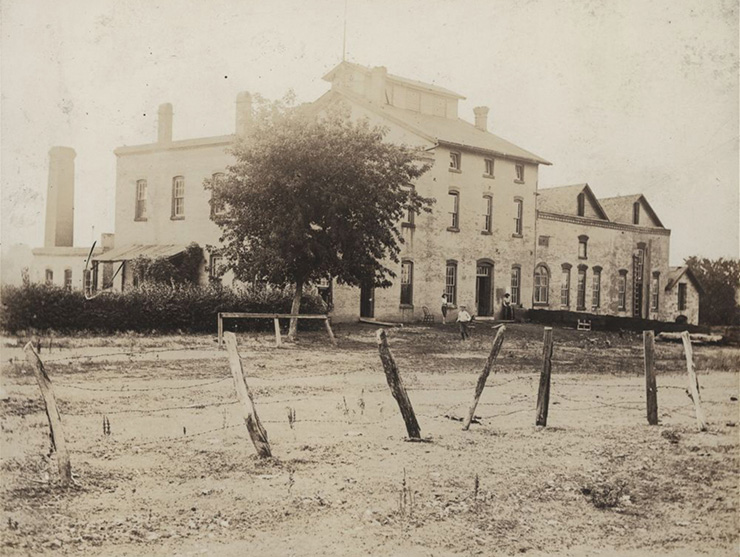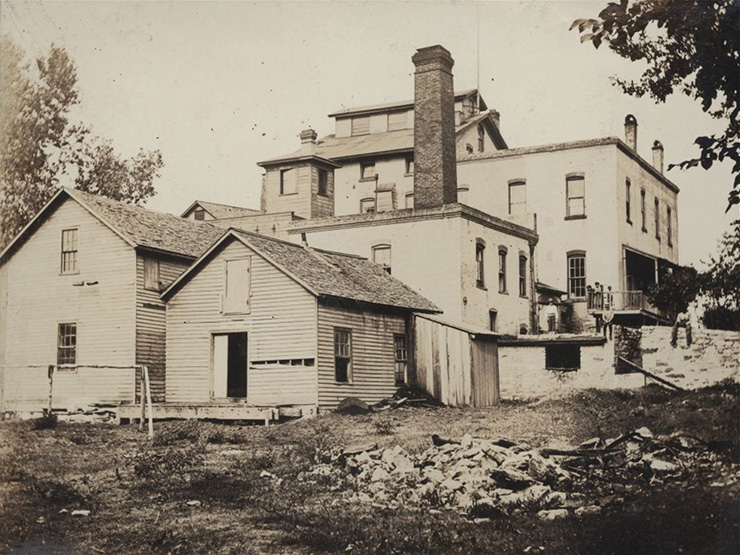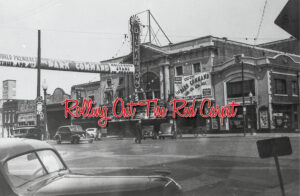Wet or Dry: Prohibition in 19th-Century Kansas
| 2016 Q4 | by Patricia A. Michaelis, Ph.D. | photos from the Kansas State Historical Society, kansasmemory.org

John Walruff Brewery Lawrence
From the opening of Kansas Territory until the mid-1980s, the availability (or lack thereof) of alcoholic beverages was a recurring political topic, with endless nuances and little enforcement. A few of the prohibition efforts with attention to Kansas territorial legislatures enacting several laws, include: “An act to restrain dramshops and taverns and to regulate the sale of intoxicating beverages passed in 1859.” Section 6 of this law stated it was unlawful to “sell intoxicating liquors to any persons intoxicated or who are in the habit of getting intoxicated, or any married man, against the known wishes of his wife.”
Other provisions of these early laws prevented to sale of alcohol to Native Americans and slaves. In some instances, the laws aimed at Native Americans were supported by tribal leaders. Prohibition discussions occurred during the various constitutional conventions, with Lawrence women presenting to the members of the Topeka Constitutional Convention a “memorial” with 90 signatures. However, despite many efforts to control the manufacture and sale of alcoholic beverages, such provisions were not included in the Wyandotte Constitution because the founders of Kansas did not want adoption of the constitution making Kansas a “free state” (banning slavery) to be sidetracked because of a controversy over provisions for sale of alcoholic beverages.
In spite of prohibition sentiment, Kansas was not “dry” in the early years of statehood. Lawrence was home to the Walruff Brewery, established in 1867 by Christian Joseph Walruff. Located on northern end of Maine Street, the Walruff Brewery was the only one in Lawrence at the time. In 1870, Christian’s brother John became a silent partner in the business by providing the capital for the operation under his wife, Elizabeth’s, name. “Kansas Breweries and Beer,” by Cindy Higgins and published with support from the Free State Brewery, describes the three-story Walruff Brewery, officially the Lawrence Brewery and Beer Gardens.
Resting on a heavy walnut foundation, the mail brewery’s upper section housed a drinking parlor on two floors where tap beer sold for five cents a glass. … The brewery gardens stretched across five wooded acres complete with lawn bowling, swings croquet wickets, strolling peacocks, and a shooting gallery. Further treats were available, too, at long rows of canopied tables with bountiful servings of pickled herring, boiled ham rye bread, pretzels, and Swiss and Limburger cheeses, according to a member of Buch’s Brass Band, a popular music group that played at Walruff’s brewery.
By 1872, John was the sole owner of the brewery, which produced more than 2,000 barrels of beer a year. He had a monopoly in the Lawrence with 23 saloons and five wholesale liquor dealerships. Given this success, John was one of the leading antiprohibition supporters, fighting the emerging efforts for a state constitutional amendment banning the manufacture and sale of intoxicating beverages.
In 1880, Kansas voters (males of course) adopted a constitutional amendment prohibiting the sale of intoxicating liquors, becoming the first state in the nation to do so. They also elected John P. St. John, a strong prohibition advocate, as governor of Kansas.

John Walruff Brewery Lawrence
In the late 1870s, prohibition supporters had been active, and several national temperance meetings were held at Lawrence’s Bismarck Grove. The first national meeting occurred in September 1878 and lasted for 10 days. Attendees listened to numerous speeches, musical performances and “praise meetings,” where individuals professed their gratefulness for not drinking alcohol and thanked mothers who taught their daughters to be temperance supporters.
In addition to detailing the events of the meeting, the Sept. 3, 1878, issue of the Lawrence Daily Journal contained an extensive description of Bismarck Grove. The author wrote of the beauty of the grove in effusive language:
Few Lawrence people have an adequate idea of the magnitude and beauty of Bismarck Grove. The conformation of the surface—perfectly adapted by nature for drives and walks; the picturesque little water basin; the finely formed panoptic plateau for the accommodation of audiences of any size or quality; the convenient adjacent areas of sparsely timbered prairie for the quartering of baggage wagons and camping; all this covered by grand old trees whose youth knew no civilized presence … .
Most residents of Douglas County have little idea of what Bismarck Grove was like in the late-19th century. The Sept. 3 article included an extensive description of the amenities for visitors.
The line of the main entrance is hemmed in by the many booths and stands always necessary in such places. Following to the left the visitor soon reaches the “Grand Pacifics” of the place. The Dicker House and the Morton House stand side by side, each with table room for 300 or 400. Still further to the left is the great barrack with its double tiers of berths, sleeping car fashion, the straw in the beds being plentifully decorated with clean linen and good blankets. To the right of the barrack, upon the summit of a slight elevation, is the grand stand with its “audience room” for 4,000 people who are protected from sun and rain by generously overspread tarpaulins and pine roofing. Beyond the grand stand, to the east, is the Bardell House, with its comfortable accommodations, full tables, and courteous corps of assistants. Turning from the Bardell House to the south and following the circuitous drive towards the main entrance, one passes a second series of smaller stands, including photograph gallery, baker’s shop, candy factory, etc. In the southeast quarter of the grounds are circular swings, shooting galleries, and various other attractions of a similar nature.
The 1878 national temperance meeting was one of the first major events held at Bismarck Grove, attracting approximately 2,000 people. National temperance meetings were held at the grove in 1879 and 1880. Bismarck Grove also hosted chautauquas, church encampments, old settlers reunions and fairs. It had its own depot, and the Kansas Pacific Railroad often offered special prices for passengers coming to these events.
Enforcement of the 1880 prohibition constitutional amendment was lax. One of the major issues for women supporting suffrage was the enforcement of prohibition laws against local drinking establishments. After an unsuccessful campaign for equal rights for women and blacks in 1867, Kansas women focused on achieving the right to vote in municipal elections, which was accomplished in 1887. Frances Willard, president of the Woman’s National Christian Temperance Union, wrote Gov. John Martin in 1888 to see if the municipal voting rights for women in Kansas were having an impact on the enforcement of prohibition laws in local communities. (Martin’s response is not available.)
Thus, the 1880 constitutional amendment did not end the availability of alcoholic beverages in Kansas, and it “stayed on the books” until 1949. The 18th amendment established national prohibition in 1920 until it was repealed in 1933. Liquor laws in Kansas remained complex. For example, in 1937, the Legislature categorized beer with an alcohol content of 3.2% or less as a cereal malt beverage (not an intoxicating liquor) available to anyone 18 years of age or older. The 1949 Liquor Control Act set up a complicated system to regulate, license and tax “package liquor” by county option. “Liquor by the drink” was illegal until 1986, but alcohol had been available via various options of private clubs.
Thus, prohibition in Kansas has a long and complicated past. Many of the 19th-century efforts were tied to the hope that Kansas would be a free and progressive state, leading the country on issues that had troubled older states. Many of the early prohibition supporters were also advocates for women’s rights because it was believed intoxication damaged homes where women had little recourse against their husbands or fathers. Treatment of alcoholism remains a concern, but these days, many Kansans enjoy their beer, craft beer, wine and mixed drinks at a variety of business establishments and at home as part of their daily life.




24 Comments
Thanks alot : ) for your post. I would really like to write my opinion that the cost of car insurance varies greatly from one insurance policy to another, given that there are so many different facets which bring about the overall cost. For example, the brand name of the auto will have a significant bearing on the cost. A reliable ancient family vehicle will have a less expensive premium than the usual flashy racecar.
https://lisinopril1st.com/# lisinopril1st
who had been killed by a car.It looked like the accident had occurred a few minutes before I happened on the sorrowful scene,ラブドール 販売
where can i get cheap clomid without a prescription: rex pharm – clomid for sale
I blog quite often and I seriously appreciate your information. The article has really peaked my interest. I will book mark your blog and keep checking for new details about once per week. I opted in for your Feed too.
buy clopidogrel bisulfate: buy Plavix Clo – clopidogrel bisulfate 75 mg
I could not refrain from commenting. Very well written.
An outstanding share! I’ve just forwarded this onto a colleague who was doing a little research on this. And he actually ordered me lunch because I stumbled upon it for him… lol. So let me reword this…. Thank YOU for the meal!! But yeah, thanks for spending some time to talk about this topic here on your blog.
п»їplavix generic buy plavix online п»їplavix generic
This is a topic that is near to my heart… Take care! Where can I find the contact details for questions?
buy dapoxetine online: max pharm – priligy maxpharm
Good write-up. I certainly appreciate this website. Continue the good work!
http://plavixclo.com/# generic plavix
I truly appreciate this post. I have been looking everywhere for this! Thank goodness I found it on Bing. You’ve made my day! Thanks again
Thank you so much for sharing this wonderful post with us.
Thanks for thr great article!
Your style is unique compared to other people I have read stuff from. Many thanks for posting when you have the opportunity, Guess I’ll just book mark this web site.
non prescription prednisone 20mg: raypharm – how much is prednisone 10mg
Good site you have got here.. It’s difficult to find high-quality writing like yours nowadays. I truly appreciate individuals like you! Take care!!
п»їplavix generic Plavix generic price generic plavix
You are so interesting! I do not suppose I’ve read through something like that before. So great to discover another person with original thoughts on this topic. Really.. thank you for starting this up. This web site is one thing that is required on the internet, someone with a little originality.
Cost of Plavix on Medicare: buy Plavix Clo – buy Clopidogrel over the counter
http://lisinopril1st.com/# buy Lisinopril 1st
buy dapoxetine online: cheap priligy – buy dapoxetine online